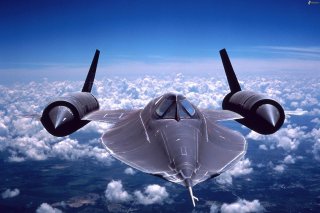3,400 Degree Temperatures: Video Shows Why the SR-71 Is a Speed Demon
It’s time to grab your favorite drink and have your jaw drop to the floor. This ultra-impressive video post, taken at Beale Air Force Base in 1986, shows the test of the SR-71 J58 engine at max afterburner power.
It’s time to grab your favorite drink and have your jaw drop to the floor.
This ultra-impressive video post, taken at Beale Air Force Base in 1986, shows the test of the SR-71 J58 engine at max afterburner power.
According to the U.S. Air Force, the “J58 engine was developed in the late 1950s by Pratt & Whitney Aircraft Division of United Aircraft Corp. to meet a U.S. Navy requirement. It was designed to operate at speeds of Mach 3+ and at altitudes of more than 80,000 feet. The J58 was the first engine designed to operate for extended periods using its afterburner, and it was the first engine to be flight-qualified at Mach 3 for the U.S. Air Force.”
It continued: “Two J58s powered the highly-sophisticated Lockheed SR-71 high-altitude strategic reconnaissance aircraft as well as its forerunners, the Lockheed A-12 and YF-12A prototype interceptor. In July 1976, J58 engines powered an SR-71 to a world altitude record of 85,069 feet and another SR-71 to a world speed record of 2,193 mph.”
Impressive indeed, but that failed to mention that the J58 generated a maximum thrust of 32,500 pounds—more than 160,000 shaft horsepower—and was the most powerful air-breathing aircraft engine devised at the time.
At maximum engine output, the fuel flow rate of the J58 climbs to roughly 8,000 gallons per hour and the exhaust-gas temperature is a blistering 3,400 degrees Fahrenheit.
At the mind-bending speeds, the SR-71 operates in, surface temperatures rise extremely high due to aerodynamic heating. Temperature readings often reached 800 degrees Fahrenheit at the nose, 1,200 degrees on the engine cowlings, and 620 degrees on the cockpit windshield.
Such extremes in speed and temperature forced designers of the aircraft to build upon the already cutting-edge technology of the time. Many features and systems simply had to be overhauled or just invented again. New oils, hydraulic fluids, sealants, and insulations were created to better deal with the ultra-hot temperatures.
According to Lockheed Martin Corporation, with the “anticipated temperatures on the aircraft’s leading edges exceeding 1,000 degrees Fahrenheit, dealing with the heat raised a host of seemingly insurmountable design and material challenges. Titanium alloy was the only option for the airframe—providing the strength of stainless steel, a relatively lightweight, and durability at the excessive temperatures.”
It continued: “Titanium, however, proved to be a particularly sensitive material from which to build an airplane. The brittle alloy shattered if mishandled, which meant great frustration on the … assembly line, and new training classes for Lockheed’s machinists. Conventional cadmium-plated steel tools, it was soon learned, embrittled the titanium on contact; so new tools were designed and fabricated—out of titanium.”
Ethen Kim Lieser is a Minneapolis-based Science and Tech Editor who has held posts at Google, The Korea Herald, Lincoln Journal Star, AsianWeek, and Arirang TV. Follow or contact him on LinkedIn.


